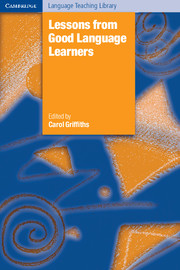Editor's overview
Published online by Cambridge University Press: 11 August 2009
Summary
Key questions
In her seminal article Rubin (1975, p. 42), suggested that “if we knew more about what the ‘successful learners’ did, we might be able to teach these strategies to poorer learners to enhance their success record.” Aptitude, motivation, and opportunity, she argued, are essential characteristics of good language learners who either have or can develop these characteristics. Rubin constructed a list of strategies typical of good language learners, who, according to her observations, are willing and able to use clues (for instance non-verbal, word association, and general knowledge) in order to guess meaning; use a variety of techniques (such as circumlocution, paraphrase, or gestures) in order to communicate or learn from communication; manage inhibitions (such as the fear of appearing foolish or of making mistakes); attend to form (for instance by analyzing, categorizing, and synthesizing); practice the language they are trying to learn (for instance by seeking out native speakers and initiating conversations); monitor both their own and others' speech (for instance by learning from mistakes); and attend to meaning (for instance by interpreting mood and intonation). These strategies, as Rubin pointed out, will vary according to a number of factors including the task, the learning stage, the learner's age, the learning context, learning style, and cultural differences. Rubin concluded by suggesting that knowledge about good language learners “will lessen the difference between the good learner and the poorer one” (p. 50).
- Type
- Chapter
- Information
- Lessons from Good Language Learners , pp. 1 - 6Publisher: Cambridge University PressPrint publication year: 2008
- 1
- Cited by



